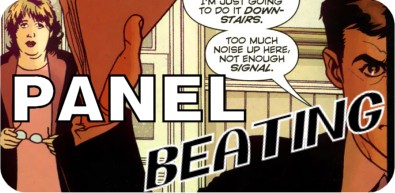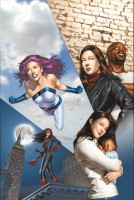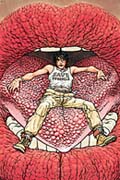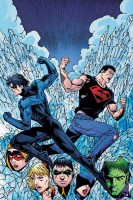Panel Beating - 13th March 2006

Aaaand we're back. We're a couple of days late, for a number of reasons - yours truly was busy on Saturday being a talking head for a student TV project about (surprise) comics, and technical problems have led to a delay in the launch of sister column Alternate Cover, so I thought I'd hold off until a day or so after James launches. Which he now has, so we can get to it.
To use possibly the oldest analogy in modern Western culture, Brian Michael Bendis books are like buses. You wait ages (well, a week or so, in this case) and then three come along at once. Time was when the bald one's control over the entire comics industry would at least be spread out evenly over the weeks. Not now, it seems, and so we get issues of Powers, Ultimate Spidey and The Pulse all at once. Meanwhile, in a ridiculously quiet week for DC, there's very little of note happening in One Year Later - it's really a quite major disappointment that they've failed to follow up last week's strong opening with anything other than Firestorm this time out - and so I'll take a look at Teen Titans #33, an Infinite Crisis tie-in; while Vertigo launch Steven T. Seagle's American Virgin. But first, it's time for a goodbye...
 |
THE PULSE #14 (PICK OF THE WEEK!)
Publisher Marvel • Writer Brian Michael Bendis • Artist Michael Gaydos
Damn you, Bendis. Damn you, Marvel. Damn whoever is responsible for ending not one, but two books featuring Jessica Jones, easily the best new character created in the Marvel Universe in a very, very long time. And damn you for making us care this much about the Jessica/Luke Cage relationship, and then pulling the plug on the story (although, thankfully, not the relationship) just as it gets going. Yeah, thanks for that.
The Pulse has had a strange life. Obviously, its main function was as a new home for Jessica following the cancellation of Alias, but it was a great new concept, the idea being to look at superhero stories from the perspective of the people whose job it is to cover them. A sort of ongoing, contemporary version of Marvels, if you like. Its biggest strength, of course, was its cast of characters - in addition to Jessica, we had the MU's finest non-superhero character - Ben Urich - to follow. And things got off to a good start, with a decent storyline about Norman Osborn that also made a surprising change to the status quo. Sadly, since then, the book has meandered all over the place, confused about its identity and roped into crossover tie-in (Secret War) after crossover tie-in (House of M).
Finally, though, with its last arc, the book sprang into life, developed a better sense of identity, and became great reading once more, Bendis forging engaging but unobtrusive links with his own New Avengers as we followed the birth of Jessica and Luke's baby, while the sadly overlooked subplot involving Ben Urich and D-Man was among the best things he's written in years.
Unfortunately, Bendis now feels the time is right to move on from a book that admittedly never really looked like achieving all that it was meant to do. An unfortunate byproduct of this is the fact that Jessica, while she'll never go ignored as long as Bendis holds sway in the Marvel offices, is now no longer the subject of an ongoing title. And so, this is a farewell of sorts. And as you'd expect, it's a terrific one. Simply put, it's a flashback to the first time Jessica and Luke met, and in true Bendis style the characterisation and dialogue, always the most important thing in his books, are spot on. Everything that makes Jessica such a great creation, and everything that Bendis has done to make Luke Cage such a credible and involving character, is here in spades. The chemistry and level of trust between the pair is immediately evident, while we get a classic demonstration of the sort of person Jessica really is, deep down, when she has to make an important decision that affects her identity.
It could perhaps be seen as a little schmaltzy, this issue, but that's not without justification - these are characters that Bendis has really made us care about, and you can therefore forgive him - and yourself - indulging in a few "Awww" moments. And meanwhile, of course, perhaps the other saddest thing about the end of this book is that the wonderful Mike Gaydos doesn't have it to draw any more. Quite simply, this is one to cherish - a perfect fusion of writer, artist and characters of the sort that just doesn't happen often enough. Damn you, Bendis. But it was fun while it lasted. A+
 |
AMERICAN VIRGIN #1
Publisher DC (Vertigo) • Writer Steven T. Seagle • Artist Becky Cloonan
A note to comics publishers everywhere - stop getting Frank Quitely to do your covers if he's not doing the internal art. I mean, sure, they'll look amazing, they'll jump off the shelves at you like a Bolland or a McKean... but all you'll then do is make people wish he'd done the internal art as well. That's not to have a pop at Becky Cloonan, mind, whose art here is more than adequate. It's just a little reminiscent of opening, say, an Alex Ross-covered issue of Earth X or something.
American Virgin, then, would seem to be - given the amount of publicity it's been generating - the latest attempt by Vertigo to find the smash hit success that's been missing from its catalogue ever since first Sandman and then Preacher ended. Unfortunately, that expectation puts a certain amount of unfair pressure on the book, because it is in truth a curious little tale that, while by no means a bad read, certainly isn't a mega smash hit in waiting; and even if it were, it certainly isn't a particularly Vertigo-ish book.
Part of the problem I find with it is that it's difficult to know what Seagle's motivation is in telling the story. There's certainly no clear sense of what side of the debate he seems to fall on. Adam's wide-eyed and slightly preachy earnestness would appear to be a ripe subject for parody; in fact, though, Seagle firmly plants him as the protagonist, a character to be supported, not rounded on. Even during the almost evangelical scene with the stripper, his words come close to ridiculous - but he is completely earnest. Perhaps it's because he's not completely perfect - he has flaws, he has doubts - that we're allowed to sympathise with him. On the other hand, of course, the story as a whole could hardly be said to be entirely in favour of the Christian Right, True Love Waits sort of movement - Adam's parents are as stereotypically cynical-money-grabbing-nutjob masquerading as loony-right-Christian as it's possible to get.
Still, perhaps it's expecting a little much to be able to glean a full sense of where the book's going after just one issue. And as a first issue, this is well-told. Seagle is very much a writer's writer, and his storytelling craftsmanship is on show here - a perfectly-judged example of setting up your situation, rattling through scenes that give you a good sense of the protagonist's character, and then whipping the rug out from under said situation and character with a sucker-punch of a last page, so that the cosy situation that's been established can never be the same again. Art-wise, as I mentioned, Cloonan's art may suffer slightly in comparison to the cover art, but that's not to say it doesn't work. There's a little inconsistency in some of the styling, mind; but this is made up for by the very subtle way that Adam's appearance deteriorates over the course of the issue, particularly when you compare the immaculate sheen of the first page to the desperate mess of the last.
Worth sticking with, anyway. It's not going to be the biggest hit Vertigo have enjoyed in years. It's not even going to be a Lucifer or a Y : The Last Man. But it's promising enough. A-
 |
POWERS vol.2 #17
Publisher Marvel (Icon imprint) • Writer Brian Michael Bendis • Artist Michael Avon Oeming
It amazes me that there are people out there still not buying Powers. Really. How is it not possible to love this book, to eagerly anticipate its arrival each month? Although on the other hand, I suppose it's a bit of a difficult one to jump on to - certainly, if I were a new reader coming onboard with this issue, I'd be completely lost. I'd also be unlikely to care about what was happening to the two characters. As it is though, I care. I damned well care. And Bendis just continues the succession of killer gut punches to all of us who've spent the last few years loving Deena Pilgrim.
What we have here, then, is perhaps the pinnacle of the contrast between the fortunes of our two protagonists (who, if I recall, have barely even spoken to one-another over the course of this storyline). Christian is on an ascent - he's got powers back for the first time since the fateful day he stopped being Diamond, having been chosen to be the new Millennium (think Green Lantern), and in this issue he basically gets to kick a load of alien arse alongside Calista, who has discovered his secret. Deena, meanwhile, who's secretly had powers for some time now, continues her descent into... well, I don't even want to speculate about where this is going. For a character who's been so carefully built up over the years, it's really heartwrenching to see what's happening to her now. It can't end well. On the other hand, it could have been even worse - there's a couple of pages in this issue where she looks like she's contemplating doing something really bad, and it's hard not to go "Oh no, Bendis, please. Don't do that. Please don't have her do that."
It's not a hugely dialogue-heavy issue, this, and so it's not one where one of Powers' greatest strengths - snappy banter - can shine. However, it's certainly one where Oeming's art and Peter Pantazis' colouring can. The scenes with Walker as Millennium are beautiful, brightly-coloured (well, as brightly-coloured as Powers gets), reflecting the joy with which he's revelling in having powers again (joy that exists even as he's fighting a terrifying battle against an alien attacking the Earth). One full-page splash in particular, as Walker and Calista fly through the city, is a dazzlingly iconic image in waiting. Plus, the Millennium costume is really cool. In Deena's scenes, meanwhile, there's an almost complete lack of colour, a dark and washed-out feel (lightened only during what are, ironically, the issue's "darkest" scenes as Deena breaks out her new powers again) that contrasts superbly with Christian's pages.
This is building to something big, and it's hard to see how it's going to end well (next month brings the last part of this arc, as #19 is apparently going to provide a good jumping-on point for new readers, which is something Bendis says about this book roughly once a year). It is, of course, utterly compelling - like driving past a car crash. A really, really gripping, well-told car crash, with great art. A
 |
TEEN TITANS #33
Publisher DC • Writers Geoff Johns & Marv Wolfman • Pencils Todd Nauck • Inks Sean Parsons, Norm Rapmund & Mario Alquiza
Or Infinite Crisis #5.5 as some wags have taken to calling it, and it's hard to argue.
Simply put, Nightwing and Superboy - essentially all that's left functioning of the Titans, new or old, as the Crisis goes on - set off, in Infinite Crisis #5, from Titans Tower to just wherever exactly it is that Alexander Luthor and the Psycho Pirate are hanging out. In Infinite Crisis #6, presumably, they will arrive. This, then, is what happens inbetween.
Marv Wolfman's return to the Titans (Geoff Johns' writing credit must surely just be for the bits that really tie in directly to Crisis) isn't a bad issue, by any stretch of the imagination. It's just a bit of a nothing issue - filler in every sense of the word, right down to the fact that it's apparently padding out Titans to the delayed #34, which will launch their One Year Later next week. It's essentially an Infinite Crisis story rather than a Teen Titans one, but for obvious reasons nothing particularly major can happen in it that would affect Crisis itself; and aside from an (admittedly potentially significant) change in Cassie's status quo, and some gap-filling exposition relating to Superboy, little can happen in terms of it being a Titans book either, given that only one of the issue's two protagonists is actually a member of the book's current team.
Still, though, there's some quite nice thematic stuff going on here. The idea of a younger counterpart to the Superman-Batman relationship has, of course, been explored before, but usually with Superboy and Robin (there is , as a matter of fact, an upcoming issue of Superman/Batman specifically about this). It's nice to see a slight twist on it by matching Superboy with the original Robin, despite the almost generational gap between them. This also provides an interesting link between the old and new incarnations of the Titans, particularly when Nightwing is (for a rather tenuously given reason) running around in his old costume.
Sadly, another element that makes its way across from Superman/Batman is the dual narration, with the two characters often thinking similar-but-different things at the same time. It feels like such a direct copy of Jeph Loeb's writing, and indeed irritates as much as it does in that book. The male bonding that occurs between two characters initially distrusting of each other, too, feels like an extremely predictable bit of plotting. The art, meanwhile, isn't exactly spectacular - solid enough in the action scenes, but inconsistent (perhaps down to three different inkers working on it), and doesn't handle the talky scenes (of which there are plenty) all that well.
It's a pleasant enough - if fairly lightweight - read, though. The sequence where that crystal thing reflects both characters' histories is a pleasing bit of nostalgia, and it's good to see Nightwing - usually the perennial heir apparent - from the perspective of someone younger, someone who sees him as a reverential figure. At the end of the day, however, it's just a little difficult to see for whom - aside from die-hard Titans fans and 'shipping fangirls - this could be anything other than "inessential". B
 |
ULTIMATE SPIDER-MAN #91
Publisher Marvel (Ultimate line)• Writer Brian Michael Bendis • Pencils Mark Bagley • Inks John Dell
When the same creative team has been working on a comic for as long as Bendis and Bagley have on Ultimate Spider-Man, there are bound to be slumps. The mark of a good comic - and, come to that, a good creative team - is how it manages to come out of those slumps. Ultimate Spidey has had a slump or two over the past five years, but on recent evidence, it's right back on form.
A problem the book has always had is that it was the first of the Ultimate titles to be launched, and the line really hadn't established what its identity was going to be, all the way back in 2000. As a result, USM has always trod a nervous path, introducing altered versions of existing MU characters and situations, but never keen on changing the core elements too dramatically. Compare this with The Ultimates and Ultimate Fantastic Four - and to an extent Ultimate X-Men - which have all made quite drastic changes to the original. The Ultimate Universe has developed its own distinct continuity by now, and while it might pay lip service to the MU from time to time, it's really not beholden to it in the same way as it might have seemed back in the early days.
What Bendis needed to do with Ultimate Spidey, then, was to take a clearly-defined step away from established (movie or comic) continuity (who didn't know that Gwen was going to die eventually, even if the speed with which it occurred took most of us by surprise?) without making it seem suddenly out of keeping with the spirit and tone of the book and characters. And in splitting up Peter and MJ and - and here's the masterstroke - getting Kitty Pryde and Peter together, by gum, he's got it.
The opening part of this issue basically follows the template that the book laid out from a very early point in its existence (and one which, let's face it, was hardly new to Spider-Man as a concept) - on a street somewhere in downtown New York, Spider-Man chases and beats on some lame villain in an even lamer costume who's just robbed a bank or something. Very funny wisecracks are thrown, villain looks stupid, Spidey wins. Simple as. This time out, though, Spidey's not alone - Kitty Pryde, mindful of the fact that people might start talking if they see her out and about with both Peter Parker and Spider-Man, has made herself a new costume to hide her identity, just so she can go on patrol with him. Oh, and she gets all the best lines, too - particular note must go to "Bonus for me", which made me chuckle, and the bit with the Ringer's wallet, which made me chuckle even more.
The reason why this works, of course, is that Bendis has finally done what various writers of Ultimate X-Men have failed to do - he's made Kitty a good character. She's still quite different from her regular MU equivalent, of course - but she's no longer simply a stereotypical vacuous, bubbly high school girl whose only purpose is just to be another young character running around. She's got a bit more depth, she's got a bit more intelligence and nous, and she even gets - gasp! - an interior monologue, which she'd surely never get the priviledge of in her own book. This in addition to out-quipping Spidey himself.
Indeed, this relationship works because it makes sense. These two characters aren't together because they're together in a different continuity. Bendis has seen the potential for the chemistry between two characters that have a fair bit in common, and he's gently crafting something believable out of it. In so doing, he's also injected a lot of this title's trademark fun back into it (although what that says about Ultimate Mary Jane, I don't know - but she had started to get a bit irritating). The book (and here I'll give a perfunctory mention, since it's hard to say much new after 91 issues, to Bagley's solid-as-ever art, with the caveat of there being a few slightly off panels that I'll put down to the inks - which have yet to really settle down since Dell took over) is once again a great read each month - nothing groundbreaking or particularly moving, but still tremendous fun. A
About this entry
- By Seb Patrick
- Posted on Tuesday, March 14 2006 @ 7:52 pm
- Categorised in Comics
- 0 comments
